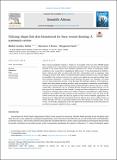Utilizing tilapia fish skin biomaterial for burn wound dressing: A systematic review

View/
Date
2024-06Author
Zimba, Bhahat
Rwiza, Mwemezi
Sauli, Elingarami
Metadata
Show full item recordAbstract
Burn wound management remains a burden in our hospitals with more than 180,000 people
dying annually due to burn-related complications. Bacterial infections further affect the healing
duration of the wound hence most treatment modalities have aimed at maintaining aseptic
conditions on the wound. Silver sulphadiazine (SSD) cream 1 % has demonstrated the ability to
bind to bacteria cell walls, its amino acids and DNA, and interferes with its respiratory chain
resulting in bacteria death. SSD is considered the gold standard treatment of burn wounds despite
its shortfalls in the treatment of burns. As a result, recent studies have focused on finding better
burn treatment alternatives. Traditional wound dressings like gauze, lint, bandages, and cotton
wool are being replaced by modern wound dressings like hydrogels, alginates, and membranes.
Despite that these modern dressings provide a moist environment to necessitate wound healing,
they also have disadvantages including limited exudate absorptive capacity and lack of antimi-
crobial effect. Alternatively, the use of tilapia fish skin biomaterial has gained interest over the
past years in the treatment of burn wounds. Its usage has been attributed to its high percent
composition of collagen type I and III and its ability to influence cell proliferation, differentiation,
migration, and synthesis of other proteins on the wound site. In this review, we focus on the
various roles that the tilapia fish skin has played in burn wound treatment applications. We
discuss how the tilapia fish skin biomaterial has been tailored to be used in different forms of
wound dressings and how its processed products have been utilized in treating burns. In this
review, we also make a proposition on how the tilapia fish skin biomaterial can be enhanced to be
an effective treatment modality for burn wounds.
URI
https://doi.org/10.1016/j.sciaf.2024.e02245https://dspace.nm-aist.ac.tz/handle/20.500.12479/2778
